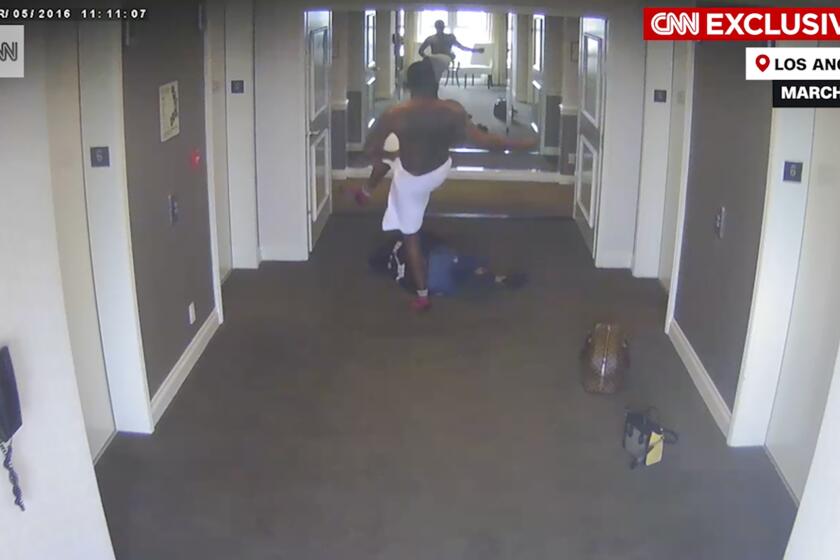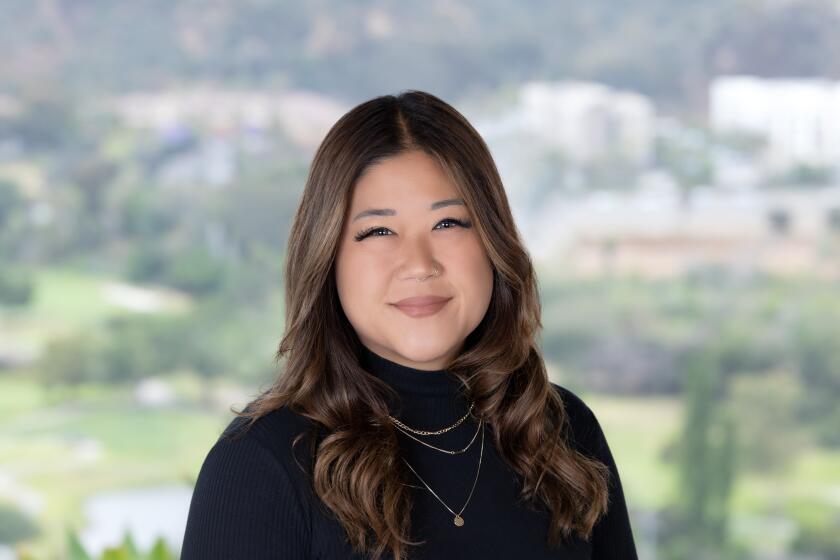New MDs Operate on Mix of Excitement, Fear
- Share via
VENTURA — Like the unflappable doctors they hope to become, the 13 medical school grads strive to project the calm, collected comportment of model physicians.
But the air crackles with nervous energy as the newly minted doctors sidle up to the conference table on this, the first day of orientation at the Ventura County Medical Center.
They are excited. And scared.
Fresh out of medical school, they fret they do not know enough to treat real patients. They fear the long, arduous hours at the hospital could break up marriages and take other tolls on their personal lives--as has happened to so many residents before them.
Worse, they worry about mistakes from sleep deprivation. And then there is the most deep-seated fear of all: being alone at the hospital at night, as the physician on call, and watching helplessly as a patient’s life slips through their hands.
For four years they have pored over books, dissected cadavers and studied deep into the night. They have crammed their weary brains with names of body parts, drugs and medical processes--but it was all theory.
Now, they will learn to apply that knowledge.
Over the next 12 months, they will rotate through every department of the sprawling Ventura County Medical Center complex--using their unpracticed hands to deliver babies, inject IVs, set broken bones and remove appendixes.
All this races through their minds as Dr. Lanyard Dial--the head of Ventura County Medical Center’s prestigious UCLA residency program--addresses the agitated, untested young doctors before him.
He adopts a warm, fatherly tone, but does nothing to allay their fears.
“You’re coming up on the worst years of your life,” Dial says matter-of-factly. “People are going to die. And you’ll feel more responsibility than you have ever felt.”
Ventura Program Ranked Among Best
In the world of family practice medicine, experts say Ventura County Medical Center’s UCLA-affiliated residency program is one of the nation’s best.
Although there is no formal ranking system, experts point to the demand among graduates from top medical schools as a barometer of the program’s prestige.
“They have literally hundreds of applications for 13 spots,” says Dr. Norman Kahn, director of education at the American Academy of Family Physicians in Kansas City. “Ventura is an excellent program. It is very well-known nationally.”
It is growing more so.
Five years ago there were 200 applications for 13 spots. This year there were 718.
Those in this year’s batch come from as far away as South Africa and as near as Los Angeles. They are here to launch their careers in family practice, beginning with three years of hard-nosed, front-line basic training.
The first year is set up to be a medical boot camp, of sorts, pushing the physician trainees more than had ever been pushed in medical school, or during any other time in their lives.
They are expected to work 80 to 100 hours a week. On one demanding rotation--caring for surgical patients--they will pull 36-hour shifts every fifth day, staying up all night and then groggily forging through another eight hours.
Adding to the strain on home life, most face mounting financial pressures. They will have to get by on $29,900 a year in salary, while up to $120,000 in student loans loom over their heads. Now that they are out of school, the payments must begin, siphoning hundreds of dollars out of their pay checks each month.
To top it off, still unhardened by years of medical crises, many will absorb the emotional distress of their patients, lugging their worries home with them at night.
Working at Ventura County’s only public hospital, they will witness the ebb and flow of life while providing medical care in a wealthy county to a class of people who can least afford it.
About three-quarters of Ventura County Medical Center’s patients are unemployed, on Medi-Cal, or uninsured, hospital records show. Nearly one-third speak no English. It’s a group with more than its share of human tragedy.
Dial likens the intensity of first-year residency to drinking from a fire hose.
“You get a little wet,” he says. “But it hurts. It’s extremely grueling. For the majority of them it will be their first experience as real doctors.”
Varied Reasons for Entering Profession
Sitting around the conference table, the doctors-in-training listen earnestly as Dial dispenses advice--and counsels them on how to survive.
Most are thrilled to have secured a place in the highly selective Ventura program. But Dial dismisses that as unimportant now.
“I’d rather have 10 dumb doctors than one smart one who can’t get along with the nurses,” he said.
He asks them to look to their right, to their left. Because these are the people who are going to be their main support network over the next three years. No one else--wives, husbands, significant others, family members, even second- and third-year residents--will understand this particular hell they go through.
The residents, some tentatively, some confidently, lean forward one by one to tell their stories.
Some have joined the medical profession out of a deeply held altruism, others inspired by physicians they know or other role models.
For Steve Mills, 32, the long road to medicine was motivated by dinner-table talk with his wife, a paramedic.
Trained as an electrical engineer, the tall, blue-eyed doctor with the strawberry blond goatee was raking in money working with computers. But he was bored.
“Even if you are a really good engineer, you end up working in the basement with oscilloscopes and electrical circuits,” he said.
At the time, his athletic, 6-foot-plus wife was a state lifeguard. “That was her thing, the lifesaving profession,” he recalls. “She would come home saying, ‘This kid was drowning, and his father went out to save him, then he started drowning, so I swam out and saved them. . . . So what did you do today, honey?’
“The next day I went in and told my boss, ‘I quit.’ ”
Six years later he has arrived in Ventura, ready to save some lives himself. He chose family practice because of the strong relationships doctors are encouraged to build with patients.
“I do my own home repairs, my own plumbing,” he says. “I take things apart, I put them back together. Family practice is the one thing that lets you do it all.”
Today’s family practice doctor is in some ways the modern-day reincarnation of the old general practitioner--except that it requires two extra years of residency like other medical specialties.
Yet unlike the 22 other board-certified specialties, family practice is the only training designed to care for the whole person, and coordinate care between more esoteric specialists.
As jacks-of-all-trades, family practice physicians can handle 90% to 95% of patients’ health needs, says Kahn of the American Academy of Family Physicians. They deliver babies, administer general anesthesia, spring into action in the emergency room.
“All the other specialists are focusing on some organ, disease, or process,” Dial adds. “But in family practice the primary focus is on the patient.”
Ventura County Medical Center began its residency training in family medicine in 1969, one of the first in the nation. Like many of the other programs, it evolved from a training program for general practitioners that dated back to 1928. In 1974 it became affiliated with the UCLA medical school.
As the only teaching hospital in Ventura County, the program functions like a magnet, drawing top-flight physicians to the county to teach, and luring promising young graduates to the area, often to stay.
“Over half the family physicians practicing in this county came through this program,” says Dr. Sam Edwards, head administrator at the Ventura County Medical Center. “This program is a tremendous source for Ventura County.”
Of 288 physicians who have completed the residency program, one-quarter still practice in Ventura County.
Broadly trained family doctors were the norm until World War II, when great leaps in medical knowledge and technology spurred a move toward specialization in areas such as surgery, anesthesiology and internal medicine.
The trend reversed itself in the late 1960s.
“The evolution of the health care delivery system has resulted in a need for family physicians everywhere,” Kahn said. “In rural communities, where they were, to the urban underserved, and in managed care, which prefers regular family physicians over any other.”
That is to say the explosion of health maintenance organizations, prefers well-rounded doctors who can meet most medical needs and function as gatekeepers to higher-priced specialists.
Following that demand, family practice training programs have grown exponentially. In 1970, there were 20 programs nationwide; today there are 465.
“In 1997, 3,500 graduates entered family practice residency programs,” Kahn says. “That’s the most ever in history. It’s the fourth record year. The pendulum is definitely swinging back toward family practice.”
Serving the Needy Is One of Center’s Goals
Unlike many family practice residency programs that churn out HMO-bound physicians, the program at Ventura County Medical Center goes out of its way to recruit medical school grads with an altruistic streak.
They have financial motivation to do so.
Each year the medical center receives $175,000 from the state to help serve the underserved population. To secure that grant, Dial must testify annually that the residency program’s graduates continue to serve the needy.
“I think certain residency programs attract a certain type of resident,” said Dr. Bill Woods, who came to the county medical center in October after two years at an HMO.
“This particular program--because of the patient population-- attracts people who are truly motivated,” Woods said. “If you went to a residency program for Kaiser, you would not see that same altruistic dedication.”
So it’s no surprise that the program draws a larger number of former Peace Corps volunteers and young Samaritans who spent time in community clinics.
The fledgling physicians say they are less bent on seeking the astronomical fees collected by some medical specialists. Instead, they crave a different reward.
That is not all that unusual for dreamy-eyed medical students. What is unusual, Dial says, is how many of Ventura’s residents will cling to their idealistic dreams even after three years in the trenches at the hospital.
Three doctors from last year’s graduating class went into the National Health Service Corps--federally designated programs, such as the Indian Health Service or public health service, to help the underserved.
Five doctors work in rural communities with populations of fewer than 5,000. One doctor works as the only physician in Avalon on Catalina Island. One works in a community health clinic in Chicago. And several stayed at the Ventura County Medical Center.
Not a single doctor from last year’s graduating class went to work at a health maintenance organization, though HMO recruiters aggressively go after those completing the prestigious program.
A survey of the past 10 years shows a similar pattern: 41% work in towns with populations of fewer than 25,000; 38% work in the Northwest, rural Alaska or mountain states such as Colorado and Idaho. Nearly one-quarter remain in Ventura County.
Only 6% of graduates from the past 10 years work for HMOs.
Following in this tradition, Christina Zaro, 26, dreams of working in a poor, tropical country with too few doctors.
It’s the same dream she has had since high school.
“I knew I wanted to be a family doctor from the start,” the soft-spoken woman says.
“There were some books I read about missionary doctors who worked in Thailand for 30 years,” she says. “I’m not interested in religious work--in the sense of someone like Mother Theresa. I am interested in helping people who are poor--who can’t help themselves.”
Last summer Zaro worked for Medicos del Mundo in El Salvador and Guatemala, under conditions that make the residency program seem luxurious.
“The salary is comfortable,” she said of the residency program. “We have warm showers. I have a car. Those places have hard living.”
But she is determined to venture overseas. “I don’t think I can settle in some suburban practice,” she says.
Fellow resident Jennifer Scott, 30, wants to serve the poor closer to home.
The bubbly, freckle-faced woman dreams of practicing medicine in a small mountain town in Northern California. The logging town of Burney--population 600--to be precise.
She worked at the tiny community clinic tucked into the mountains during her final year of medical school. There she found her inspiration embodied in a country doctor, Tom Watson.
“I idolized this man who had gone to Ventura,” Scott says. “He was so dedicated to his patients. So good at holding the babies. So good at doing the procedures. And he was superbly trained. I wanted to be him.”
Andrew Bruton, another first-year resident, picked the Ventura program because he wanted to help the Latino population and practice his Spanish.
“I hoped to make a positive contribution, specifically to the underserved,” said the Virginian with long, brown hair. “I went to Mexico and tried to follow that path.”
After trying his hand as journalist with an English language daily newspaper in Mexico City, Bruton returned to Washington and volunteered as an interpreter at the Washington Free Clinic in a largely Spanish-speaking neighborhood.
It was there, he says, that he found his calling.
“That was an amazing experience,” he says in his slow Southern cadence. “People would come off the streets, from the inner city. They wouldn’t have much money. Often they had no insurance. We would see anyone, based on their medical problems.”
White Lab Coats Mark a Big Step in Process
As the first morning seminar draws to a close, the young doctors rush from the medical education room to be fitted with the white lab coats--the vestments that distinguish them as doctors.
“It’s important for young doctors to receive a white coat with their name on it,” Dial says. “For patients, they anticipate that the person walking through the door will come in looking like a doctor. It’s a therapeutic thing for the patients to see.”
The residents, short and tall, thin and pudgy, rummage through the pile of new white jackets. They posture and ponder the doctorly image they want to project. Should the lab coat be short and sporty? Or long and authoritative?
“That felt good,” says Mills, the former engineer, stretching his arms into the white sleeves of his lab coat.
“I have my MD now,” he says. “But in this first year I will really become a doctor. That’s what I hope. So when I say ‘Dr. Mills,’ I won’t feel like I’m pretending.”
Zaro feels a mixture of angst and delight as she dons her white coat.
“I am most nervous about being on call,” she confesses. “I’ve tagged along, but I never had to make a decision.”
She pauses for a moment of reflection.
“I can’t quite grasp that I’ve gotten my MD,” she says. “The idea of being treated as a doctor--of having a prescription pad with my name on it--is very exciting.”
*
About This Series
Making of a Doctor: A Boot Camp for Family Medicine is an occasional series following medical school graduates through their first-year residency at the Ventura County Medical Center. Today’s first installment focuses on the residents’ initial exposure to the prestigious, and arduous, family practice program affiliated with UCLA. Future stories will focus on residents’ experiences in the hospital and caring for the poor.
More to Read
Sign up for Essential California
The most important California stories and recommendations in your inbox every morning.
You may occasionally receive promotional content from the Los Angeles Times.










